|
1.
CENTRAL AND WEST AFRICA
Price corrections anticipated
The FOB prices shown below are for pending contracts
and the indications are that downward corrections are
likely. As of mid-July, producers anticipate a drop in the
price for belli and weakening prices for okoume and the
redwoods.
Analysts suggest that Chinese mills in Gabon, Cameroon
and Congo which supply the Chinese market may switch
to milling species for the EU market, especially azobe and
fear this could disrupt this steady and quiet market.
In contrast to the market in China, demand remains strong
in the Philippines driven by the need for timber in the
aftermath of severe typhoons.
Cameroon
Heavy rains have returned but log stocks are reported as
adequate for the coming months. The rain season is
expected to continue until December. Mills are building up
sawn stocks in preparation for the six-month rain period.
Roads are in good condition and railways are functioning
without major disruptions. Container availability is
sufficient with enough empty containers in stock in
Cameroon.
Producers in Cameroon say, while demand in Middle East
markets remains stable, the slowdown in demand from
China has of considerable concern. Inquiry levels are
reported as stable.
There are reports the authorities are becoming strict on
sawnwood exports with all mills having to produce legal
verification papers for each truck of sawnwood heading to
Douala or Kribi. The aim, it is suggested, is to foster a
change in mentality towards legality.
Producers report slowing demand in Portugal and Spain
traditionally good markets for sapelli. In Belgium there is
said to be stable demand for iroko, padouk and doussie.
Parcels being prepared for shipment in mid-July will
arrive towards the end of the European holiday season. In
the Netherlands there is a steady demand for azobe.
Gabon
The country is still struggling with electricity power
outages which are seriously impacting production and
heavily disturbing the plywood companies. The local
water and electricity supplier, SEEG, promised
improvements by the end of the month but the problem
remains unresolved with SEEG citing low water levels in
the dam due to insufficient rain.
Adding to the challenges in Gabon is the shortage of
skilled local technicians. The government decided to
reduce the proportion of expatriates employed in mills and
this has led to protests by the industry, particularly those in
the Nkok Special Economic Zone where veneer and
plywood industries struggle with the lack of experienced
local technicians.
The government has set quotas for the employment of
foreign labour in Gabon. These are 15% of the workforce
for executives, 10% for supervisors and senior technicians
and 5% for operational staff. The cumulative maximum
level of employment of foreign labour in is 30%.
The Ministerial statement says " This decree has three
objectives: to give priority to hiring nationals and to
promote the Gabonese workforce; to restrict the use of
foreign labour in positions of responsibility; to align the
issuance of employment permits with market needs.,"
The country is in the dry period but harvesting has slowed
due to low demand for some species. Work has started in
preparation for the coming rainy season and is
concentrated on road maintenance and building log stocks.
Trucking to the ports has improved due to ongoing road
works with all-weather laterite roads under repair. Roads
are dry but the Bifoun to Ndjole road, the main route for
timber and food trucks from Cameroon, is in poor
condition.
The railway operator has increased the allocation of
wagons for log transport but obtaining wagons for
sawnwood transport is said to be difficult. Negotiations for
a second railway track from the Koulamoutou area
towards Mayumba on the coast appears to have stalled but
it has been reported that a South African/Australian
company is now studying a rail track from Koulamoutou
(southeast Gabon) to Owendo/Libreville.
Desire-Clttandre Dzonteu, writing for the gabonreview,
reports the production index for the timber sector in the
first quarter of 2024 was up 10% compared to the last
quarter of 2023. This information was provided by the
Ministry of Economy and Investments through its latest
Sectoral Economic Outlook Note. The gabonreview says
the plywood index gained 25% quarter of 2023, the
sawmill index 7% and the index for veneers gained 14%
quarter-on-quarter.
See: https://www.gabonreview.com/gabon-embellie-de-10-de-
lactivite-des-industries-du-bois-au-1er-trimestre-2024/
Congo
In North Congo the rains are easing allowing for better
transportation to Douala Port which is closer than Pointe
Noire in the south but some disruption has been reported
as not all the roads to the port are surfaced.
The south of the country is currently dry and harvesting
has resumed. With Chinese demand slowing sawmills are
forced to seek alternative markets. Despite the initial ban
on log exports quotas have been allocated due to the
economic situation with old log stocks allowed for export.
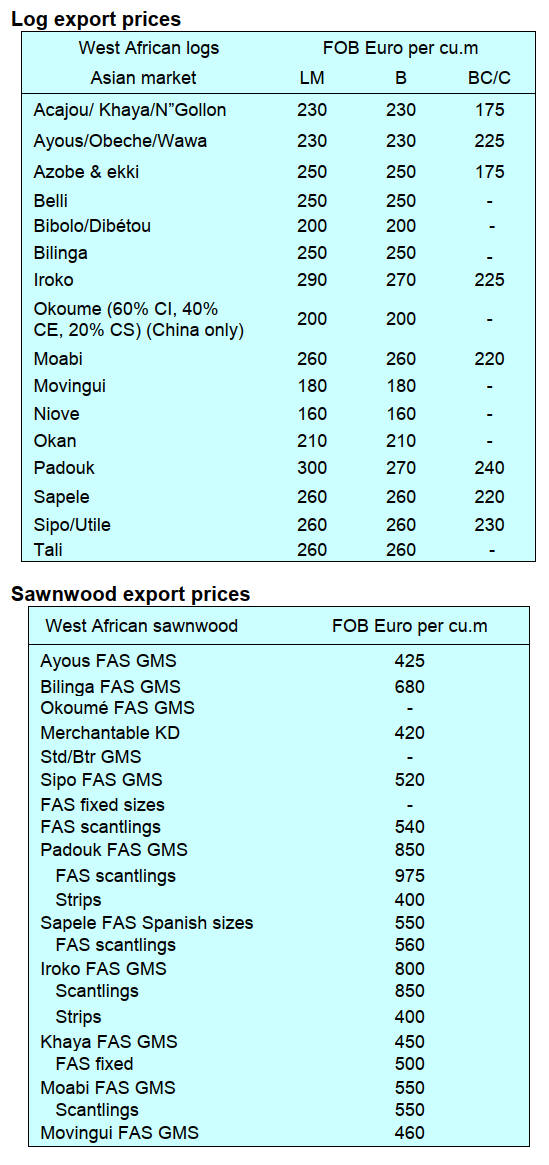
2.
GHANA
Millers call for investment in plantations
The Ghana Timber Millers Organisation (GTMO) is
warning that the remaining 25 member companies are
struggling to secure raw materials for production and fear
imminent closure.
Chief Executive Officer of the GTMO, Dr. Kwame
Asamoah Adam, highlighted these concerns in an
interview with Citi Business News saying “now, in terms
of the numbers, the medium to large size companies, most
of them have ceased operations”.
He added, the materials that are coming in, especially
round logs, the volume has fallen from about 1.2 million
cu.m about 20 years ago to just around 500,000 cu.m.
In related news, the GTMO has called for new, large-scale
commercial plantations to sustain the industry and ensure
the continuous flow of logs to the processing mills.
According to the GTMO Executive Officer commercial
tree plantations established by industry players would have
solved Ghana’s timber supply problem. He said it was
mow time timber firms to engage in large-scale tree
planting to produce raw material for their operations and
ensure the sustainability of Ghana’s timber industry.
He expressed these views at the 11th delegates’
conference of the Timber and Woodworkers Union of the
Trade Union Congress (TUC) in Kumasi on the theme:
“Sustainability of the timber industry in an era of climate
change: The role of social partners”.
He emphasised the need to invest to correct the damage to
the country’s forest due to climate change. He further
explained that most timber companies in the country had
collapsed because bushfires had decimated the forests.
Ghana’s government, through the Green Ghana Day
Initiative launched in 2021, has enabled the country to
make significant strides in forest restoration. Over 42
million trees of various species have been planted across
the country to cushion the effects of climate change and to
replant degraded forests. However, according to President
Nana Akufo-Addo, there is still much work to be done in
the area of forest restoration and protection in the country.
See: https://citinewsroom.com/2024/07/wood-shortage-looms-as-
75-out-of-100-local-timber-manufacturing-companies-
collapse/#google_vignette
and
https://gna.org.gh/2024/07/commercial-plantation-is-the-future-
of-the-timber-industry-dr-asamoah-adam/
https://3news.com/news/ghana-has-made-significant-strides-in-
forest-restoration-but-much-work-remains-akufo-addo/
Dip in wood product exports in the first four month of
2024
According to data from the Timber Inspection
Development Division (TIDD) of the Forestry
Commission (FC), Ghana exported 86,755 cu.m of wood
products in the first four months of 2024, 12% down
compared to 98,959 cu.m in the same period last year. The
export value was EUR39.29 million in the first four
months of 2024, 12% less than EUR44.56 million in the
same period last year.
Mouldings, plywood to the regional market, billets and
sliced veneer all recorded decreases of over 20% in
volume terms during the four-month period. Products
recording more modest decreases were air and kiln
driedsawnwood and plywood for international markets.
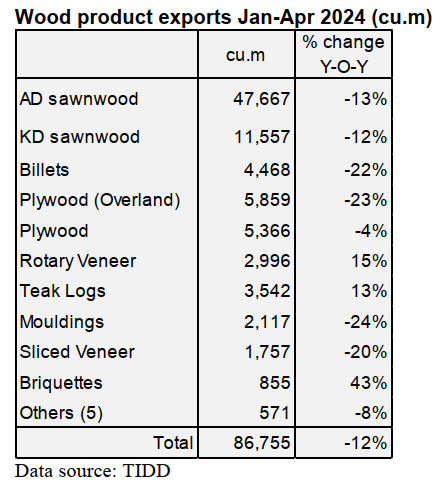
For the four-month period exports of sawnwood were
59,224 cu.m in 2024 compared to 68,050 cu.m in 2023
while plywood was 11,225 cu.m in 2024 compared to
13,207 cu.m in 2023 and veneer was 4,753 cu.m in 2024
and 4,812 cu.m in 2023.

Of the country’s major export markets during the period,
Asia (54%), Europe (21%) and Africa (10%) accounted
for most of the EUR39.29 million total export receipts in
the first 4 months of 2024 compared to the EUR44.55
million recorded in 2023.
Forestry Commission trains staff to tackle forest
ecosystem destruction
The Forestry Commission (FC) of Ghana has trained
seventy staff in the Rapid Response Unit during a three-
week rigorous military training exercise at the 64 Infantry
Regiment Training School at Asutsuare in the Eastern
Region of Ghana.
The training was intended to equip the staff with skills in
unarmed combat, patrolling, ambush, obstacle courses,
and marksmanship and the ability to accurately handle
firearms.
This formed part of tougher measures by the Commission
aimed to tackle illegal loggers, gold mining and farming in
forest reserves which have become a danger to forest
management. The Commission is aware thar some illegal
operators carry deadly weapons in the forest.
See: https://fcghana.org/rru-trains-7o-staff/
https://www.ghanabusinessnews.com/2024/07/03/forestry-
commission-calls-for-stiffer-punishment-for-forest-offenders/

3. MALAYSIA
Furniture furnishings trading platform
The Malaysian Furniture Furnishings Market (MFFM) is a
new trading platform designed to provide an effective,
convenient and dynamic experience on furniture and
furnishings products for both exhibitors and buyers. It is
aligned with the prime furniture trading season in
September and visitors are invited to joining MFFM 5 to 7
September 2024 at the World Trade Centre Kuala Lumpur
(WTCKL).
Beyond addressing global furniture needs, MFFM is
committed to driving industry advancement by
establishing itself as a collaborative hub with the objective
of accelerating the development of the industry. The
MFFM exhibition will focus on furniture, home décor and
lifestyle products, finishing materials, hardware and
accessories.
See:https://mffmfurniture.com/
Sarawak to reduce log harvest
The Sarawak State government, through the Forest
Department will, according to Deputy Premier Awang
Tengah Ali Hasan, reduce annual log harvests to about
two million cubic metres and ensure adherence to forest
management certification criteria. In this regard the
Premier emphasised the importance of aligning the State’s
forest management with international standards which
would allow timber products to be marketed competitively
globally.
The State government has said it aims to boost income
from forest and the Premier called on all parties involved
to collaborate towards realising the State’s Sustainable
Development Goals (SDGs) and to back the reduction of
greenhouse gas emissions by 45% by 2030.
Hasan called on forest license holders in Sarawak to
actively engage in forest restoration programmes,
particularly in degraded areas. These efforts are crucial for
creating economic opportunities in carbon trading, agro-
forestry and ecotourism, he said.
See:
https://forestry.sarawak.gov.my/web/subpage/webpage_view/1242
Debate on introduction of carbon tax
Experts are divided on Malaysia’s proposed
implementation of a carbon tax policy, with some
believing that it is a timely initiative, while others deem
that the country is not ready to consider such a move.
Universiti Tunku Abdul Rahman economics professor,
Wong Chin Yoong, said a carbon tax policy is not timely
as the country still has more important reforms to deal
with for now.
See: https://www.thestar.com.my/business/business-
news/2024/07/03/mixed-views-on-carbon-tax-introduction
4.
INDONESIA
Export Benchmark Prices of wood products
for July
2024
The following prices are applicable 1-31 July, 2024.
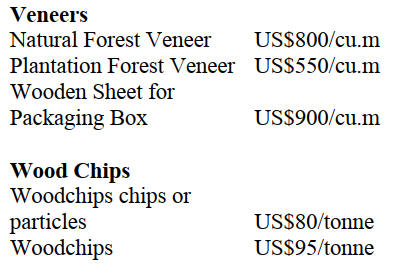
Processed Wood
Processed wood products which are level on all four sides
so that the surface becomes even and smooth with the
provisions of a cross-sectional area of 1,000 sq.mm to
4,000 sq.mm (ex 4407.11.00 to ex 4407.99.90)
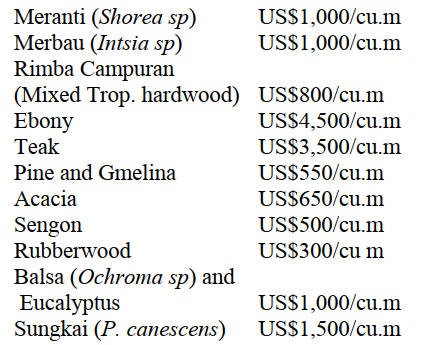
Processed wood products which are level on all four sides
so that the surface becomes even and smooth with the
provisions of a cross-sectional area of 4,000 sq.mm to
10,000 sq.mm (ex 4407.11.00 to ex 4407.99.90)

See:
https://jdih.kemendag.go.id/pdf/Regulasi/2024/802_Kepmendag
%20HPE%20dan%20HR%20Produk%20Pertanian%20dan%20
Kehutanan%20Juli%202024%20dan%20Lampiran.pdf
Upstream and downstream collaboration could
boost
sector performance
Krisdianto, the Director of Forest Product Processing and
Marketing Development at the Ministry of Environment
and Forestry, said collaboration between upstream and
downstream businesses could revitalise and strengthen the
performance of the timber industry in the country. Adding
that integration among industry players will bolster the
wood supply chain and support the production of high-
quality export products.
At a June meeting in Surabaya Krisdianto mentioned that
efforts are needed to address challenges created by the
Forest Utilisation License (PBPH) and Forest Product
Processing License (PBPHH). A mechanism for
cooperation between PBPH and PBPHH holders needs
further improvement to ensure a stable supply of raw
materials for PBPHH and a market for roundwood for
PBPH. Such integration would address the problem some
companies have to market roundwood and primary
industries will no longer suffer from a shortage of raw
material, he said.
Tjipta Purwita, the APHI Management Board member,
explained that production from the natural forest in 2023
was 4.7 million cu.m whereas the average over the last 10
years was 5.7 million cu.m. He added that several factors
are causing a decline in natural forest wood production.
One is the increasing transportation distances and fuel
prices, while wood prices remain constant. Additionally,
there is a decreasing trend in the demand for wood from
natural forests.
Tjipta also suggested that expanding the export market,
especially for mixed forest wood, is essential to increase
added value as it has not been utilised optimally so far.
See: https://forestinsights.id/tekad-pelaku-industri-kayu-hulu-
hilir-dongkrak-kinerja-pemanfaatan-kayu-rimba-campuran-
dipromosikan/
Processed wood industry plays strategic role in the
economy
The processed wood industry is considered to have a
strategic role in the national economy and significantly
contributes to the Gross Domestic Product (GDP)
according to Prof. Mangku Purnomo, the Dean of the
Faculty of Agriculture at Brawijaya University.
During a discussion hosted by FPUB as part of an ITTO
project, Purnomo communicated the need to develop a
comprehensive national strategy to enhance the
competitiveness of processed wood products in the
domestic market. He said "through the project advantages
and challenges in the domestic wood industry will be
studied.
Several important issues related to the processed wood
industry were discussed. The research findings from this
project confirm that the domestic market holds great
potential for the national wood industry.
The focus of the discussion was on strategies to enhance
the competitiveness of processed wood products in the
local market, particularly through product innovation,
quality enhancement, and improved production efficiency.
See: https://www.rri.co.id/bisnis/783536/industri-kayu-olahan-
dinilai-berperan-strategis-untuk-perekonomian
Rattan furniture popular in international markets
Indonesia's high-quality rattan furniture has gained
popularity among foreign importers, including those
operating in Japan, according to Deputy Minister of Trade
Jerry Sambuaga, during a visit to the office of Kimura
Rattan in Osaka, Japan
The value of Kimura Rattan's imports from Indonesia has
shown a steady increase, rising from US$2.11 million in
the period October 2020 to September 2021 to US$2.33
million in the most recent recording period. Sambuaga
emphasised that Indonesia's Ministry of Trade had
committed to supporting and facilitating the exports of
high-quality rattan products to Japan. In this regard, he
remarked that the ministry's Indonesia Trade Promotion
Center (ITPC) in Osaka will always be ready to help
promote and enhance products and find solutions to issues
that might arise.
See: https://en.antaranews.com/news/317775/indonesias-rattan-
furniture-gains-popularity-says-trade-official
Need for forest recovery strategy for Java
The Environment and Forestry Ministry has highlighted
the need for a strategy and cooperation among
stakeholders to accelerate forest and environmental
rehabilitation in Java. "The success of forest and land
rehabilitation on the island of Java involving the
community has made a real contribution to improving the
environment and forest functions and local economic
welfare," said the Ministry's Secretary General, Bambang
Hendroyono.
Hendroyono remarked that forest and land rehabilitation
can support the achievement of Indonesia's Forest and
Land Use (FOLU) Net Sink 2030. He explained that
sustainable restoration of the forest ecosystem in Java
must focus on the existing regulations without forgetting
the aspects of best practices and effectiveness.
See: https://en.antaranews.com/news/317106/govt-presses-for-
comprehensive-strategy-for-forest-recovery-in-java
Geo-AI technology can help prevents deforestation
During the 2024 Oslo Tropical Forest Forum (OTFF)
meeting, Director General of Environmental Law
Enforcement of the Ministry of Environment and Forestry
(KLHK), Ratio Ridho Sani, emphasised the importance of
legal consistency in the application of Geospatial Artificial
Intelligence (GeoAI) science and technology.
"Using accurate data and information is essential in law
enforcement. To acquire precise data, a multi-layer, multi-
tool analysis must be conducted to monitor and enforce
security in forest areas, including fires, encroachments,
and environmental pollution," explained Ratio Ridho.
He mentioned that leveraging technology with
multi-layer
analysis, including the use of GeoAI, has accelerated and
enhanced the accuracy of detecting and intervening in
activities associated with deforestation and environmental
pollution and destruction.
See: https://investor.id/international/365794/di-pertemuan-oslo-
norwegia-klhk-tegaskan-teknologi-geoai-cegah-deforestasi
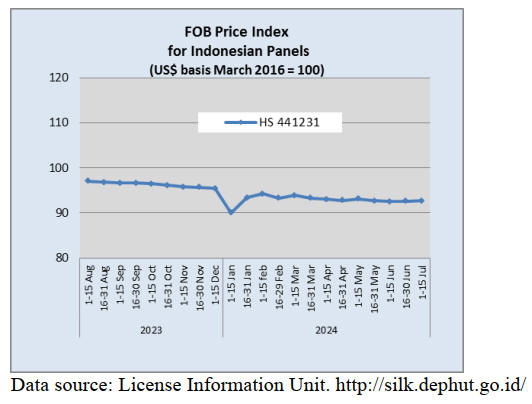
Concluding the comprehensive economic
partnership
agreement (CEPA) with the EU
Indonesia is currently trying to close the comprehensive
economic partnership agreement (CEPA) with the EU by
next month. Negotiations for this trade pact have been
ongoing for eight years. The CEPA negotiations and the
environmental policies are not the only things that can
describe the bilateral relations according to EU
Ambassador to Indonesia Denis Chaibi. “Our most
significant engagement is in trade. We are doing intensive
trade negotiations” Chaibi said, acknowledging that the
EU’s environmental regulations were also a pivotal issue
in their bilateral interactions.
See: https://jakartaglobe.id/news/indonesiaeu-relations-much-
bigger-than-just-trade-envoy
5.
MYANMAR
Wood industries undermined by payment restrictions
Current international banking restrictions on foreign
exchange transactions have severely impacted exporters,
with the wood industry being hard hit. After the EU and
USA imposed restrictions on Myanmar, citing that trade
supports the military government, manufacturers have
struggled to receive payments for their exports.
Even exports to non-EU and non-USA destinations are at
risk due to the banking restrictions. If this situation
remains unchanged the timber industry faces a serious
threat of a complete shutdown say loacal analysts. This
year so far timber exports are at the lowest ever recorded.
China’s diplomatic efforts with Myanmar
The local media has reported that China continues to
engage with Myanmar's former generals hoping they can
restore stability.
Despite these efforts the Myanmar authorities continue to
face internal conflict and international pressure.
It has been reported that the US has also opened limited
communication with Myanmar's military suggesting a
potential shift in approach.
See: https://www.gnlm.com.mm/former-president-u-thein-sein-
attends-70th-anniversary-of-five-principle-of-peaceful-
coexistence-in-beijing/
Energy shortages
Myanmar is grappling with acute electricity shortages
which are having profound economic repercussions. The
power cuts are disrupting all businesses without exception.
The unpredictable outages are affecting operations,
causing significant revenue losses and forcing irregular
working hours on employees.
The broader economic impact of the power crisis is
evident across Myanmar. Many businesses report severe
challenges due to the unreliable electricity supply
compounded by inflation and the devaluation of the local
currency. The World Bank's findings underscore the
widespread impact of power outages, with a notable
increase in the percentage of companies citing electricity
shortages as their primary operational hurdle.
Despite the onset of the rainy season offering temporary
relief by reducing electricity demand for air conditioning
and replenishing hydropower dams, reports indicate that
industrial areas in Yangon still face an erratic electricity
supply.
See: https://www.channelnewsasia.com/business/russian-firms-
eye-myanmar-energy-infrastructure-4469846
and
https://www.frontiermyanmar.net/en/power-cuts-bring-
myanmars-industry-to-its-knees/
Banks face administrative action
The authorities in Myanmar announced administrative
action against executives from seven private banks for
exceeding the Central Bank's cap on home mortgage
lending set in January 2019. These banks will face charges
under Section 154 of the Financial Institutions Law which
allows the Central Bank to impose fines, restrictions or
terminate staff and board members. Officials at the Central
Bank will also be punished for inadequate supervision.
The cap restricts banks from lending more than 5% of
their total lending portfolio for home loans exceeding
three years. This cap was introduced by the previous
civilian government.
See: https://www.irrawaddy.com/business/myanmars-generals-
berate-and-scold-bankers-as-financial-crisis-deepens.html
and
https://www.irrawaddy.com/business/myanmar-banks-restrict-
cash-withdrawals-as-financial-crisis-intensifies.html
In related news the Central Bank of Myanmar (CBM)
has
intervened by injecting millions into the financial market
to stabilise the currency but with limited success. The kyat
continues to lose value against the US dollar, Thai baht,
and the Chinese yuan.
6.
INDIA
The correspondent
writes “the monsoon has set well
across India and we are looking forward to a good season.
The rain came two days sooner than expected bringing
relief from the heat wave while boosting prospects for
bumper harvests. Monsoon rains are critical to boost
economic growth as good harvests of rice, corn, cotton,
soybeans and sugarcane brings money into households and
lifts their purchasing power”.
Inflation higher in May
The annual rate of inflation based on the India Wholesale
Price Index (WPI) was 2.61% in May 2024. The positive
rate of inflation was primarily due to increase in prices of
food articles, manufacture of food products, crude
petroleum and natural gas, mineral oils and other
manufacturing. The index for manufacturing increased to
141.7 in May from 140.8 for April.
Out of the 22 NIC two-digit groups for manufactured
products, 13 groups saw an increase in prices, for 8 groups
there was a decline in prices and for 1 group there was no
change.
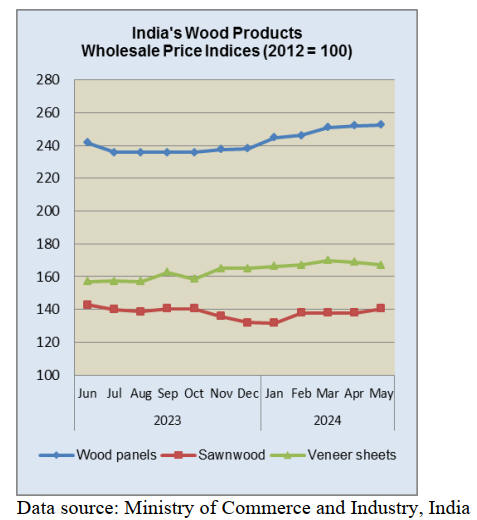
Some of the important groups that showed month-on-
month increases in price were basic metals, food products,
computer, electronic an optical products, electrical
equipment, other manufacturing. Some of the groups that
witnessed a decrease in prices were fabricated metal
products (except machinery & equipment) other non-
metallic mineral products, chemicals and chemical
products, tobacco products and other transport equipment.
See: https://eaindustry.nic.in/pdf_files/cmonthly.pdf
Government and private sector join to expand rubber
plantations
The Indian Natural Rubber Operations for Assisted
Development (INROAD) has converted nearly 70,000
hectares of land into rubber plantations in Northeast India
over the past 3 years. INROAD is hosted by the Ministry
of Commerce and Industry and brings together the rubber
consuming sector and government agencies to fund rubber
plantations. The private sector is represented by the
Automotive Tyre manufacturers Association (ATMA).
Over 30 million trees have been planted across 93 districts
in the North-east Indian states. The project entails socio-
economic development of resource poor populations in
these States.
The industry has committed Rs.1000 crore towards a new
plantation of 2 lakh hectares and another Rs.100 crore
towards improvement in quality of Natural Rubber (NR)
through best practices and training.
The demand-supply gap for natural rubber in India
continues to be high. At present nearly 40% of the
natioanal requirement is met through imports.
It is estimated that by 2030 the country would require
about 20 lakh tonnes of natural rubber annually and the
INROAD project will help meet some of the growing
requirements within the country.
See: https://www.thehindubusinessline.com/economy/agri-
business/inroad-project-brings-70000-hectares-under-natural-
rubber-in-north-
east/article67887224.ece#:~:text=Against%20the%20target%20o
f%2080%2C000,said%20Anshuman%20Singhania%2C%20Chai
rman%20ATMA.
Farmers encouraged to plant sandalwood
The latest budget includes support for boosting
sandalwood cultivation which has generated optimism
among farmers. Officials say steady demand and better
prices are key to lifting sandalwood cultivation.
One suggestion is to transform Forest Department timber
depots into sandalwood collection centres allowing
individuals to harvest sandalwood trees from private land
and sell directly to the Forest department.
A retired forest official residing at Moolamattom is
reported as saying “to encourage sandalwood planting the
government should train forestry and revenue offices on
the relavent laws and regulations as most of the officials
are unaware of the cultivation of sandalwood and the
reality is that anyone can easily cultivate the tree and earn
income.“
See: https://www.thehindu.com/news/national/kerala/budget-
announcement-to-promote-sandalwood-cultivation-offers-new-
hopes-to-farmers/article67818022.ece
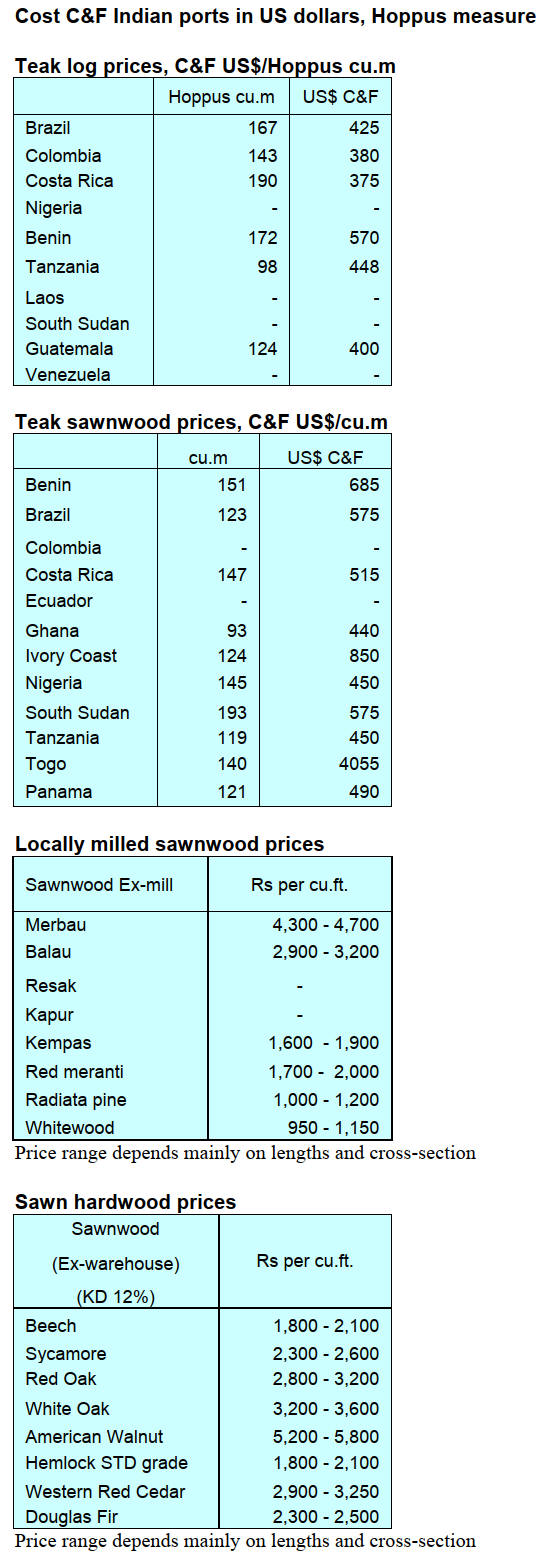
Plywood
Plywood manufacturers have agreed price increases but
the new price structures have not been released primarily
because panel demand is currently slow and company
finances are under stress. Any move by manufacturers to
raise prices now could further undermine demand.
The correspondent writes - manufacturers are not in a
position to revise the prices yet because if they do so then
their orders will decrease. But soon a point has come
where without increment their survival will become even
more difficult. I expect that by this month end all major
players will increase prices.
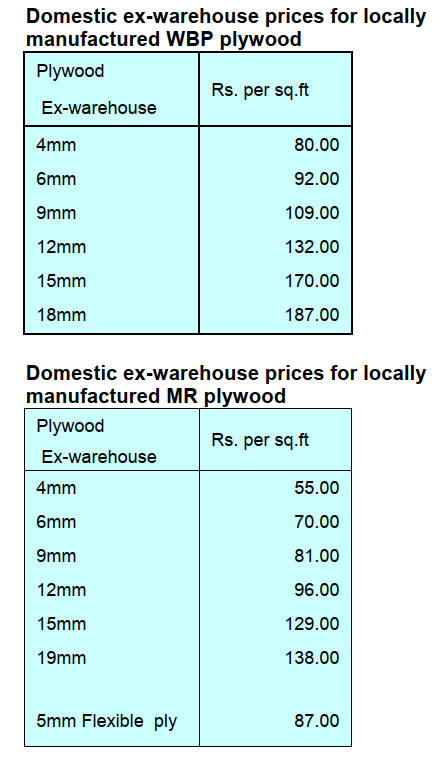
7.
VIETNAM
Wood and wood product (W&WP) trade
highlights
Statistics provided by Vietnam Office of Customs reveal
that in June 2024 W&WP exports reached US$1.25
billion, down 1% compared to May 2024 but up 14%
compared to June 2023. WP exports alone earned US$840
million, up 0.6% compared to May 2024 and up 10%
compared to June 2023.
In the first 6 months of 2024 W&WP exports earned
US$7.4 billion, up 22% year on year. WP exports
contributed US$5.03 billion, up 21% over the same period
in 2023.
The value of Vietnam's W&WP imports in June 2024 was
US$250 million, up 0.9% compared to May 2024 and up
31% compared to June 2023.
Over the the first 6 months of 2024 W&WP imports
totalled US$1.266 billion, up 22% year-on-year.
Logs and sawnwood (raw wood) imports in June 2024
were 510,400 cu.m, worth US$168.4 million, up 1.5% in
volume and 1% in value compared to May 2024.
Compared to June 2023 imports increased by 24% in
volume and 24% in value.
In the first 6 months of 2024 imports of raw wood totalled
2.5 million cu.m, worth US$838.4 million, up 18% in
volume and 11% in value against the same period in 2023.
Vietnam’s NTFP exports in June 2024 brought in about
US$70 million, up 5.5% compared to May 2024 and up
0.8% over the same period in 2023.
In the first half of 2024 NTFP exports were valued at
US$404.54 million, up 13% over the same period in 2023.
W&WP exports to Canada in May 2024 reached US$16.5
million, up 5% compared to May 2023. In the first 5
months of 2024 W&WP exports to Canada reached US$94
million, up 24% over the same period in 2023.
W&WP exports to South Africa in May 2024 contributed
US$360,000, down 18% compared to May 2023. In the
first 5 months of 2024 W&WP imports from South Africa
reached US$2.4 million, up 48% over the same period in
2023.
Imports of padouk in May 2024 came to 8,300 cu.m,
worth US$3.3 million, up 7.5% in volume and 7.4% in
value compared to April 2024.
Compared to May 2023 imports fell by 8% in volume and
by 16% in value. In the first 5 months of 2024 imports of
padouk reached 47,000 cu.m, worth US$19.2 million,
down 15% in volume and down 9% in value year-on-year.
Raw wood imported from the EU in May 2024 increased
for the 3rd consecutive month reaching 73,000 cu.m with a
value of US$23.0 million, up 12% in volume and 11% in
value compared to April 2024.
However imports declined by 1.5% in volume and
increased by 0.5% in value over the same period in 2023.
In the first 5 months of 2024 imports of raw wood from
the EU reached 272,510 cu.m, with a value of US$87.2
million, up 3% in volume and 8% in value year-on-year.
First half 2024 W&WP exports grew at double digit rate
In the first half of 2024 W&WP exports totalled around
US$7.4 billion, up 22% year-on-year. The high-end/higher
value commodity group, dominated at US$5.03 billion, up
21% over the same period in 2023. Leading these exports
were wooden frame seats, living room and dining room
furniture (US$1.0 billion, up 38%), wood-based panels
and floorings (US$814.7 million, up 25%) and bedroom
furniture (US$772.7 million, up 32%).
Data from Vietnam Office of Customs show strong
growth of W&WP exports to the US, China and the EU.
In the first 5 months of 2024 the US imported US$3.3
billion, up 26% over the same period in 2023. The US is
the main target market for made-in-Vietnam furniture.
China, as the second largest market, imported W&WP
valued at US$887.8 million, up 51% over the same
period in 2023.
Exports to the EU were valued at US$240.3 million,
up
33%, Canada US$94 million, up 24%, UK US$89.7
million, up 18% and Indonesia US$77.8 million up
102.3%.
With the gradual recovery of the world economy,
especially the 5 top markets namely the US, Japan,
China, South Korea and the EU, many Vietnamese
businesses have secured orders until the end of 2024.
Because of this imports of raw wood have been
increasing.
However, in the second half of 2024 there will be
still
many challenges facing Vietnamese operators such as
intense geopolitical conflicts and rising freight rates. In
addition, trade protection remedies relating to anti-
dumping anti-subsidy and countervailing investigations
as well as the environment/forest protection barriers,
including EUDR, are all expected to impose further
pressure on Vietnam’s W&WP exports.
Strengthening enterprise governance, improvement of
designing capability, fostering digital transformation,
diversifying export destinations by taping potential
markets, such as the Middle East, Africa, Eastern Europe
and Northern Europe, along with others, are expected to
be tackled by Vietnamese entrepreneurs.
Rising imports of wood raw material
According to Vietnam’s Department of Forestry in the
first 5 months of 2024 the area of newly planted
commercial forests was 98,200 hectares, up 1.3% over the
same period last year and the timber harvest amounted to
741,300 cu.m, up 6.6
Shippers of wood raw material
In the first 5 months of 2024, the volume of raw wood
imported from major suppliers such as China, the EU, the
US, Thailand, Chile, Laos, Brazil and New Zealand
increased over the same period in 2023. On the other hand
imports from Cameroon, Malaysia, Congo, Suriname and
Indonesia declined.
Most raw wood imports were from China and accounted
for 17% of the total import volume in the first 5 months
of 2024 reaching 348,500 cubic metres worth US$137.1
million, up 72% in volume and 40% in value over the
same period in 2023.
Imports from the EU increased 4% in volume and 9% in
value over the same period in 2023 reaching 275,300
cu.m, worth US$88.6 million and accounted for 14% of
total imports.
Imports from the US increased by 18% in volume and
18% in value reaching 255,400 cu.m worth US$110.1
million and accounted for 13% of total imports.
Imports from other shippers also increased over the same
period in 2023 such as from Thailand by 27%; Chile by
88%; Laos by 3.4%; Brazil by 40%; New Zealand by
26%; and Papua New Guinea by 71%.
Import from other sources in the first 5 months of
2024
decreased against the same period in 2023 such as from
Cameroon down 36%; Malaysia down 13%; Congo
down 33%; Suriname down 28% and Indonesia down
7%.
Import prices
In the first 5 months of 2024, the average import price
stood at US$332.4/cu.m, down 7.4% over the same period
in 2023.
The import price of raw wood from China decreased by
19% down to US$393.4/cu.m; from Cameroon decreased
by 3.5% to US$425.4/cu.m; Chile by 5%, to
US$235.1/cu.m; Laos by 4% to US$461.8/cu.m; Brazil
by 5.5%, to US$248.1/cu.m.
Vietnam’s W&WP exports to S. Africa
According to statistics from Vietnam Office of Customs
W&WP exports to South Africa in May 2024 reached
US$360.000, down 18% compared to May 2023.
However, in the first 5 months of 2024 W&WP exports to
South Africa earned US$2.4 million, up 48% year-on-
year.
Amongst W&WPs exported to South Africa wooden
furniture has been dominating at 68% of total exports.
Leading exports was living-room and dining-room
furniture reaching US$756,000, up 45% over the same
period in 2023 followed by wooden frame chairs
US$243,000, up 7%; bedroom furniture US$224,000, up
21. In addition, in the first 4 months of 2024, wood-based
panels and floorings shipped to South Africa also
increased sharply.
According to statistics from the International Trade
Center (ITC), South Africa's imports of wooden furniture
in the first 3 months of 2024 reached US$24 million, up
26.5% over the same period in 2023.
China and the EU were the 2 main suppliers. Vietnam
was the 4th largest supplier, but the value of imports
from Vietnam accounted for only 6% of the total
imports.
In the South African market, rapid urbanisation has
led to
increased demand for furniture.
Vietnamese operators are still facing many
challenges
while having their wooden products shipped out to the
South Africa especially competition with Chinese
exporters, and import payment procedures.
Padouk sawnwood and log imports
According to statistics of Vietnam Custom Office, sawn
padouk imported into Vietnam in the first 4 months of
2024 volumed at 34,8000 cu.m, worth US$13.9 million,
down 16% in volume and 10% in value over the same
period in 2023.Imports of padouk round wood reached
4,400 cu.m, worth US$2.2 million, down 6% in volume
but up 32% in value over the same period in 2023.

The average price of padouk imported into Vietnam in
the first 4 months of 2024 stood at US$410.5/cu.m, up
11% over the same period in 2023. Of this, the price of
padouk imports from Africa increased by 0.6% to
US$310.5/cu.m, from China by 2.4%, to US$286.7/cu.m
and Tanzania by 1.4%, to US$290.5/cu.m.
Padouk suppliers
In the first 4 months of 2024 padouk was imported mainly
from Africa with a small volumes from other sources.
Import from Africa accounted for 77% of total imports in
the first 4 month of 2024, reaching 30,200 cu. m, worth
US$9.4 million, down 24% in volume and down 24% in
value over the same period in 2023. Imports from Angola
decreased by 68%; Namibia by 54%; and Cameroon by
61%.
Similarly, imports from Laos decreased by 2% in
volume
and by 8% in value over the same period in 2023, with
the import of 3,500 cu.m, worth US$3.5 million.
In contrast, padouk imports from Thailand increased
by
122% in volume and 266% in value over the same period
in 2023 reaching 3,500 cu.m, worth US$2.6 million.
In addition, the import volume of padouk from some
other markets increased (Hong Kong increased by 118%,
China increased by by a huge magin, Papua New Guinea
increased by 89.8%). The net contribution from these
suppliers was small as the volumes are small.

8. BRAZIL
Improving competitiveness
of Brazil's timber
industries
The Senai Institute of Technology in Wood and Furniture
(Instituto Senai de Tecnologia - IST) has completed a
project in partnership with the Wood Industries Union
(Sindusmadeira).
This initiative, made possible by the FIEP Innovation
Programme, brought significant technological advances to
the wood industry in Guarapuava Municipality (Southern
Brazil) especially in improving production processes. The
project included eight companies from Sindusmadeira and
ended in May 2024.
IST carried out laboratory tests and technical analyses and
implemented actions to improve the quality of wood
products. The main objective was to improve the quality
of plywood and other wood products using national and
international standards as a reference. The project also
aimed to reduce losses and costs and to train employees on
technical standards, process organisation and quality
control.
Participating companies had the opportunity to carry out
laboratory tests on their products to collect technical
information that is essential for entering new markets. The
technological and process improvements implemented
strengthened collaboration between IST and the timber
industries in Guarapuava Municipality and increased the
market competitiveness and quality of products.
See: https://www.madeiratotal.com.br/instituto-senai-de-
tecnologia-em-madeira-e-mobiliario-melhora-a-competitividade-
da-industria-madeireira/
Forestry sector and technological innovation in Brazil
The Brazilian forestry sector has emerged as an essential
pillar for agribusiness contributing significantly to the
economy, society and the environment. In 2022 the sector
registered a contribution to GDP of R$107.2 billion,
representing 4.1% of the national agricultural production.
This was in contrast to an almost 2% decline contribution
from the overall agricultural sector.
Brazil has been investing heavily in technology to increase
efficiency and reduce costs in forestry production. This
investment includes the use of drones, remote sensing,
geographic information systems, biotechnology and
genetic improvement as well as the application of big data
and artificial intelligence systems.
The application of biotechnology techniques has also
supported the development of more resistant and
productive forest species adapted to Brazil's climatic and
environmental conditions. The forestry sector in Brazil
stands out for investing in innovation that combines high
technology with sustainable practices. In 2022 the area
planted reached 9.94 million hectares and comprised
mainly with eucalyptus (7.6 million hectares) and pine
(1.9 million hectares), almost double the 5.1 million
hectares planted in 2013.
The selection of high-performance seedlings and clones is
still carried out manually requiring the human expertise
ensuring employment in rural areas. In addition to the
economic impact,the forestry sector promotes job creation
and income distribution especially in rural areas.
See: https://agrorevenda.com.br/opiniao/a-importancia-do-setor-
florestal-e-a-inovacao-tecnologica-no-brasil/
Boosting exports of wood products from sustainably
managed forests
In June 2024 the "Export More Brazil (Exporta Mais
Brasil)" programme, organised by the Brazilian Trade and
Investment Promotion Agency (ApexBrasil) was held in
Alta Floresta Municipality in the state of Mato Grosso in
the Amazon region.
The goal was to boost exports of processed wood products
from sustainably managed forests. The event brought
together 12 international buyers from seven countries
(South Africa, Germany, Belgium, France, Mexico,
Poland and Uruguay) for business rounds with 30
Brazilian companies in the sector.
The programme included visits to industries to observe
sustainable practices and raise the international perception
of Brazilian products in terms of the sustainability, the
functioning of the local market and its potential.
The Brazilian Forest sector, which already employs
160,000 people in more than 11,000 companies, stands out
for job creation and the adoption of sustainable practices.
The state of Mato Grosso, with over 5 million hectares of
managed forests, is an example of this as satellite
monitoring, the adoption of traceability techniques as well
as the control of harvest volumes has been adopted.
According to the Mato Grosso Environment Secretariat
(Sema-MT) sustainable forest management in the region
contributes an estimated 16% reduction in greenhouse gas
emissions. By 2030 the expectation is to achieve 6 million
hectares of forest under SFM in Mato Grosso.
ApexBrasil, through the "Export More Brazil" programme,
aims to position the country as a world reference in
sustainable forest management, promoting economic
development with environmental responsibility.
In 2023, with an investment of R$5 million, the “Export
More Brazil” programme completed 13 business events in
13 Brazilian states. The programme generated R$275
million in business transactions and promoted 3,496
business rounds between 143 international buyers from 41
countries and 487 Brazilian companies. In 2024 the
programme will visit the other 14 states in the country.
See: https://cipem.org.br/noticias/exporta-mais-brasil-chega-em-
alta-floresta-mt-para-impulsionar-o-manejo-florestal-sustentavel-
nacional
US announces new contribution to Amazon Fund
The domestic media has reported the United States has
announced a new contribution of US$47 million to Brazil's
Amazon Fund reinforcing the collaboration between
Brazil and the United States for the protection of the
Amazon rainforest. This contribution highlights the
priority of environmental issues on the United States'
agenda on promoting policies aimed at reducing carbon
emissions and combating climate change.
The relationship between Brazil and the United States is
essential, particularly considering the Amazon's
importance in global climate regulation.
Continued support for the Amazon Fund is crucial as
maintaining robust environmental policies and funding
programmes such as the Amazon Fund are vital for the
preservation of the forest and for global efforts to combat
climate change.
See: https://g1.globo.com/politica/blog/valdo-
cruz/post/2024/07/05/eua-anunciam-nova-contribuicao-de-us-47-
milhoes-para-o-fundo-amazonia.ghtml
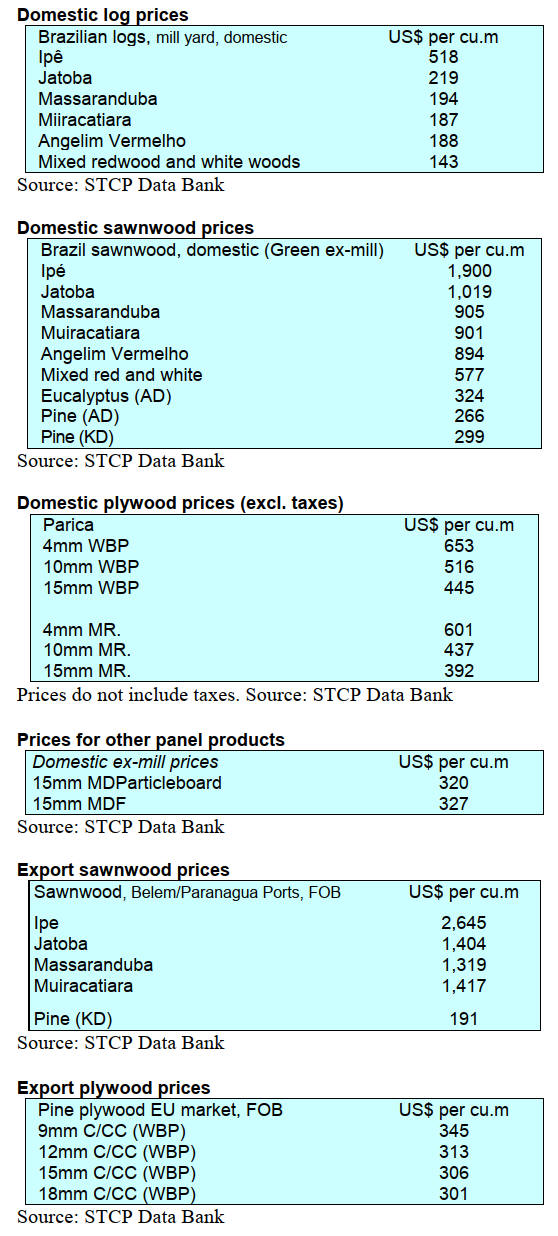

9. PERU
Furniture imports
rose during the first quarter of 2024
During the first four months of 2024 the value of Peruvian
imports of wooden furniture was US$15.3 million, an
increase of 8% compared to the same period in 2023
(US$14.1 million).
Brazil maintained its position as the main supplier of
wooden furniture to Peru during the first four months
contributing US$9.8 million, which represented 64% of
the country's total wooden furniture imports. After Brazil,
China supplied wooden furniture worth US$1.8 million a
decline on the US$1.9 million imported in the first four
months of 2023.
Wood product export earnings down year on year
According to the Management of Services and Extractive
Industries in the Association of Exporters (ADEX)
shipments of wood products in the first four months of
2024 earned US$26.6 million, which was 29% less than
the same period in 2023 (US$37.4 million)
This decline is partly explained by the lower purchases by
the main buyer, China, which at US$ 4.1 million, was a
42% drop year on year. On the other hand, the Dominican
Republic increased imports from Peru to US$3.9 million.
France, which was ranked third in purchasing Peruvian
wood products bought just US$3.8 million, down by half
from the same period in 2023.
According to figures from ‘ADEX Data’ the Trade
Commercial Intelligence System, sawnwood was the top
export product in the first four months of 2024 earning
US$10.6 million, despite a 27% drop compared to the
previous year. Second were semi-manufactured products
that earned US$9.6 million but this represented a year on
year contraction of 42%.
Others export products were furniture and its parts
(US$1.6 million), construction products (US$1.5 million)
and wood energy products (US$1.4 million).
OSINFOR reports progress in fight against illegal
logging
The Forestry and Wildlife Resources Supervision Agency
(OSINFOR) announced a notable reduction in the rate of
illegal logging in forest units with permitting titles. This
information was provided at an event to commemorate the
16 years of OSNFOR establishment
OSINFOR presented the results of a study "Estimating and
measuring the legality of wood in Peru in 2021" which
offers a standardised and replicable methodology to
annually measure illegal logging and trade in illegal wood
in the country.
When presenting the results the Director of OSINFOR,
Ildefonzo Riquelme, indicated that in 2023, 884,577
hectares of forest were under supervised management and
by the end of 2024 it is planned to extend this to 932,694
hectares.
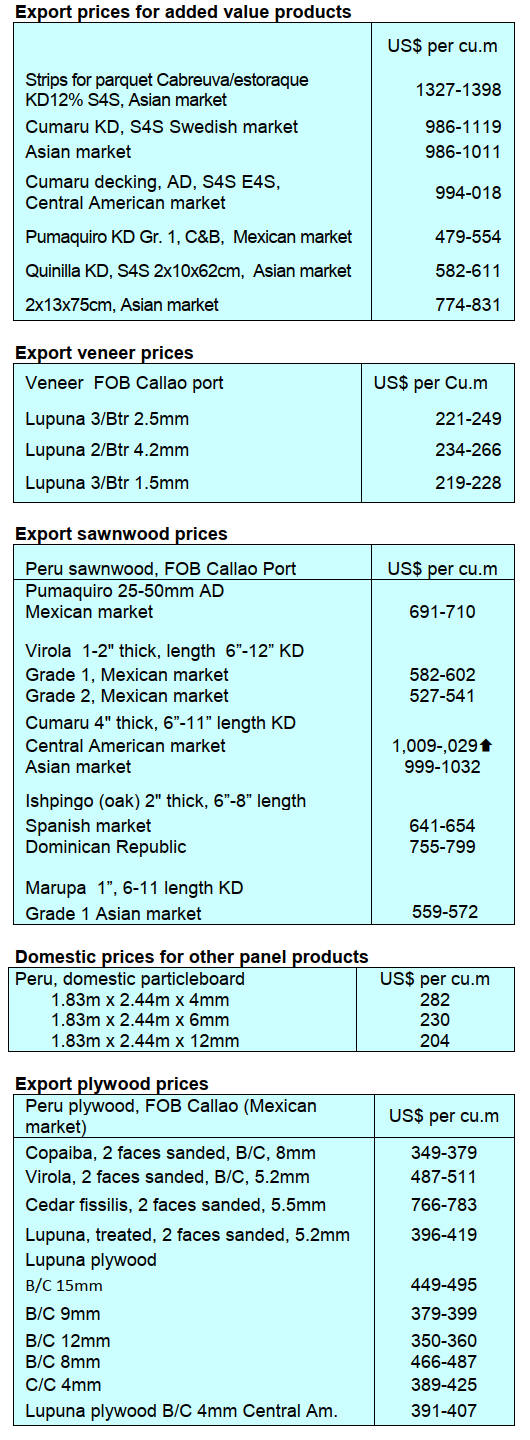 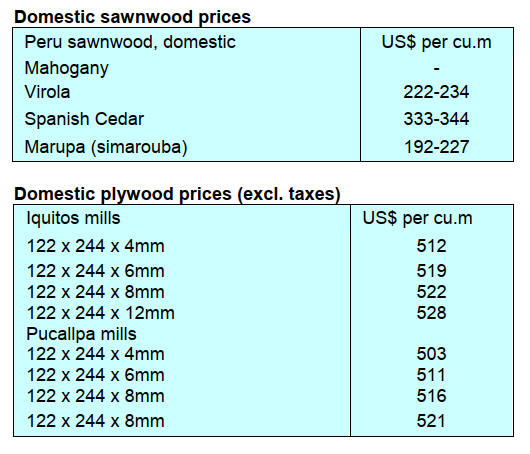
|